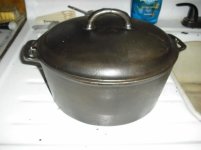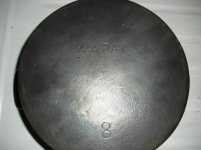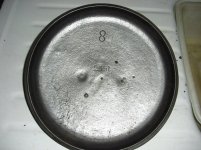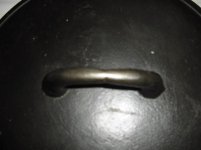I got this Wapak dutch oven a little while ago, and have used it a few times so far. It is in really great shape, and just the size I needed.
-
If a web search for the answer to your cast iron cookware question has brought you directly to this forum, the information you seek may be covered in one of the many reference topics featured on the main website.
Quick Links: · Main Website · How to Identify Unmarked Pans · All About Cleaning & Seasoning · Reproductions & Counterfeits · Commonly-Used Terms
You are using an out of date browser. It may not display this or other websites correctly.
You should upgrade or use an alternative browser.
You should upgrade or use an alternative browser.
Wapak #8 Dutch Oven
- Thread starter SeanD
- Start date
FYI, your lid is an early Griswold DO lid. These ovens originally came with a flat style lid. Sounds like your lid works just fine for you though and is probably better for a user piece with the dome giving it a little more headroom for a roast. I found a #9 like this last year and they are nice pieces. Kind of wish I hadn't sold mine.
Wapak using an Erie DO and lid as a pattern.
The bottom might be based off an Erie piece but I still say the lid was made by Griswold. From what I have seen any oven with this straight Wapak mark used a flat lid and all the domed lid Wapak ovens were fully marked on the top or underside of the lid with Wapak markings. Also to the best of my knowledge the early Erie ovens with the squared bottom edges like this one has all had flat lids with three digit pattern numbers and the later Erie ovens with the rounded bottom edges were the first to use the domed lid and four digit numbers which means if they were copied by Wapak they used a mismatched set which I doubt happened.
Last edited:
Wapak started business at the tail end of the Griswold "Erie" marking period. There exist domed Erie DO covers with four-digit 2xxx pattern numbers. Since Griswold's sizing remained fairly consistent over its lifetime, and given Wapak's penchant for copies made primarily from Griswold product, I wouldn't discount their copying a lid other than the one that originally came with the pot.
There exist domed Erie DO covers with four-digit 2xxx pattern numbers.
I agree with you there, thats what I said above "... the later Erie ovens with the rounded bottom edges were the first to use the domed lid and four digit numbers...".
My assumption the lid is also a copy (we know the pot is) is based on a couple of other things. Wapak may have been good about covering names on the pieces they copied, but they weren't necessarily that fastidious about changing/filling in other marks like size and pattern numbers. The lid in the photo looks like it fits rather well. Since the pot, being a copy made using an actual pan as a pattern (or the basis of one), would have to be smaller than the pot it copied (due to iron shrinkage as it cools so real patterns are made larger than the desired casting dims), one would assume an original lid, being larger than the copy pot, would likely not fit properly. Lid/pot joints on Griswold DOs were pretty impressive tolerance-wise, so one would expect them to fit either a Griswold DO or a slightly larger diameter pot, but probably not anything even slightly smaller. The other thing that I see is the handle appears not quite as well-done as I would expect from Griswold, and it's the one thing about a lid that Wapak would have been on their own in making it, as they would have had to fabricate their own removable "prongs" in order to create the molds.
The lid fits really well onto the DO, it seals pretty well for a Wapak in my opinion. Its a user for me, and I plan to keep it in great shape like all my other CI. Thank you both for your input!
here is a pic of the handle, not a very good one tho.
here is a pic of the handle, not a very good one tho.
Attachments
Yea I guess I forgot about the shrinkage factor which is kind of ironic since my friend just picked up two Griswold double skillet lids a couple weeks ago and I was showing him the size difference between them because one is an obvious recast. It is a heavy rough casting that must have been done on the side by someone working in a foundry that didn't cast cookware.
My initial assumption on the lid above was that it was an original Erie piece because the pattern number is so prominent and all the Wapak skillets I've had with Griswold numbers the markings have been clearly visible but fairly shallow. Normally when you take an original of something and make a copy then another copy of it a lot of the detail is lost.
My initial assumption on the lid above was that it was an original Erie piece because the pattern number is so prominent and all the Wapak skillets I've had with Griswold numbers the markings have been clearly visible but fairly shallow. Normally when you take an original of something and make a copy then another copy of it a lot of the detail is lost.




